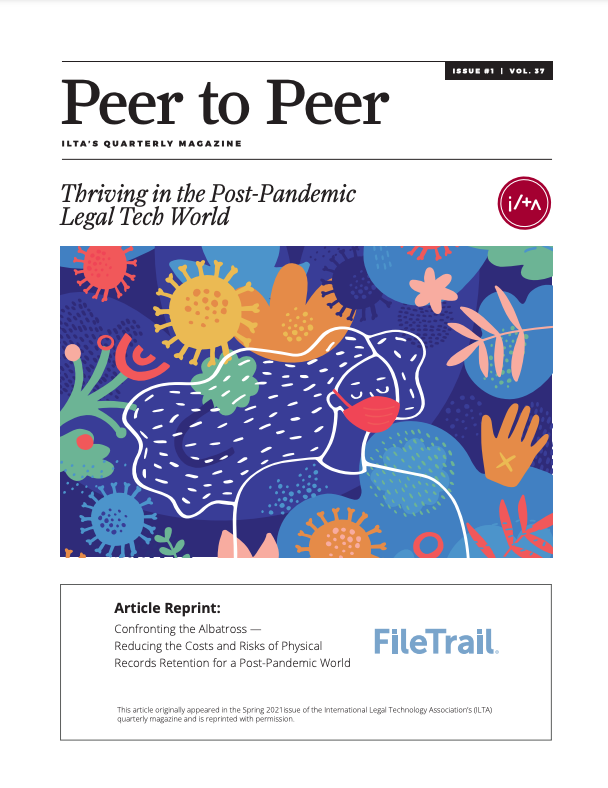Confronting the Albatross: Reducing the Costs and Risks of Physical Records Retention for a Post-Pandemic World
BY DARRELL MERVAU, President, FileTrail
Is a vast stockpile of physical records obstructing your digital transformation efforts? The rapid transition to remote working in 2020 accelerated most firms’ efforts to “go digital”—with many reporting that more lawyers and staff than ever are embracing change. In a world where no one is certain if or when the office environment will ever be the same again, there has been a massive shift away from paper-based processes toward using electronic files, online applications and digital workflows.
Yet the fact remains that most firms are still weighed down by a huge volume of physical records residing in offsite storage— tens of thousands of boxes. Typically, these have accumulated over decades, cost millions to store and manage each year and expose the firm to significant security, litigation and compliance risks. Without clear policies and procedures for record retention and destruction, firms run the risk of violating government regulations, information governance policies and clients’ outside counsel guidelines, and incurring unnecessary risks and costs that no organization can afford in these challenging economic times.
But there is hope—and several possible paths to a more paperless future. In this article, we’ll explore strategies to deal with “the albatross”—the backlog of aging paper records that continues to haunt most law firms. We’ll start by examining how many firms dealt with their “paper problem” during initial pandemic lockdowns, then turn to how firms are approaching the longer-term issue of what to do about several decades’ worth of records stored offsite.
While it may be tempting to try to digitize every physical record, in practice this has always been prohibitively costly. Instead of rushing to scan everything, it makes sense to take a step back and start with the question, “Do we really need to keep everything in the first place?” Maximizing efficiency while minimizing risks in the age of COVID-19 and beyond requires informed and decisive action to eliminate the deadweight of records that arguably should have been destroyed a long time ago, in tandem with automating workflows for retention and disposition on an ongoing basis. Reducing the backlog is important, but vigilance and planning are also critical to prevent the albatross from continuing to grow.
An Awkward Stopgap
As lockdown orders went into effect across much of the U.S.—and the world—in March of 2020, a top priority for most law firms was maintaining client service, with operations teams doing whatever it took to make sure that lawyers could continue working safely and without disruption.
While most of the focus was on enabling lawyers and staff to work remotely, the inconvenient reality was that the gravitational pull of paper remained constant. Paper documents continued to be delivered to the office; many lawyers and staff still needed access to their paper files; and inevitably some physical records needed to be retrieved from offsite storage.
In practice, law firm operations teams took various approaches to managing the paper problem. Many sent individual employees into the office to retrieve paper files, receive deliveries and arrange to have documents and other items taken to lawyers’ homes.
Interestingly, many firms received far fewer requests to retrieve physical records from offsite storage during lockdown than they had initially expected. But where this did become an issue, firms again took a range of approaches—in some cases having a member of the records management team going to the storage facility to pick up the requested files and then arranging delivery to the lawyer who had asked for them.
The drawbacks of sending staff to the office or to storage facilities to pick up and then deliver physical documents and records are clear in terms of both the costs (time and money) as well as the risks (health and safety, as well as security, confidentiality and data protection). An alternative approach is to scan paper documents as needed, so that they can be sent electronically to the requestor ASAP.
The Rise of Scan On Demand
“Scan on demand” services have surged in popularity since the start of the pandemic. Offsite storage facilities allow their clients to submit file requests for retrieval and scanning, and then send the digital version of the record to the client via an agreed upon format such as a secure download site.
The law firm RM team can then open and save the retrieved file to the firm’s document management system and send an email to the original requestor when the digital copy of the record is available. Meanwhile, the paper copy is returned to the storage facility for safe-keeping.
By converting the physical records to digital files as needed, the firm avoids sending paper files to lawyers’ homes, saves on shipping related costs and reduces the risk of files being lost during transport and delivery. The lawyer receives the requested files quickly and can continue client work.
Today, many offsite storage facilities require clients to submit their retrieval requests as a list of files in a spreadsheet — either via email or a web portal. After searching for the requested files, the storage vendor manually updates the spreadsheet with the status of each file — whether it was successfully retrieved, already destroyed or simply not found — and sends it back to the client. It is then up to the law firm RM team to manually update the status of each file within their own records management system and determine how to track both the physical and digital versions of each record.
Ideally, it should be possible for records managers to log in to their RMS and instantly see which files have been requested, as well as the status of each record. The most advanced systems have this capability, although many storage vendors are not yet able to respond to and interact in real time with their clients’ systems.
Once you have “scan on demand” or “image on demand” in place to address short-term requirements, it’s time to turn to the bigger question of how to deal with the albatross of the entirety of your physical records. What is the best way to deal with the backlog residing in offsite storage over the long term — and prevent it from sinking the ship?
The Total Cost of Mass Digitization
Is digitizing everything an option? After all, if the goal is to “eliminate paper,” wouldn’t the logical step be to simply digitize all the records you are storing? The problem comes down to cost. Digitizing several decades’ worth of physical records tends to be an expensive proposition.
On the one hand, in-house corporate law departments in industries such as pharmaceuticals, banking and financial services may find that “scan everything” is a viable solution because they are required by law to keep records over a longer period of time. Once the records are scanned, the paper copy is destroyed, reducing storage costs significantly.
Depending on the volume of records, companies embarking on large-scale digitization projects may also find that they have considerable leverage in negotiating the cost of scanning. The main challenge, then, is to ensure that the records management team has a system in place to track the scanned records, preferably with a unified view of all records held by the firm across all repositories.
On the other hand, law firms with an extremely large volume of physical records, including those that are 25-30 years old, typically find it makes more sense to cull large batches of aging records — 99% of which will never be looked at again — and to scan the rest on an as-needed basis.
In other words, rather than postponing the day of reckoning through mass digitization, for most law firms it pays off in the long run to confront the albatross as soon as possible
Facing Up to Destruction
Remember: When taking on the albatross, there is no need to panic. If you find yourself con-fronted with 20-40 years’ worth of physical records to dispose of, a workable alternative to trying to “destroying everything ASAP” may be to plan the disposition in phases.
For example, you can plan disposition by decade — records from before 1970, followed by matter closings from the 1970s and then 1980s matter closings.
Modern RM systems enable the quick determination of who the main reviewers are. Typically, the older the matter, the less likely the responsible attorney is still with the firm, so it becomes straightforward to limit the review to a group of senior partners. In many cases, these reviews happen much more rapidly than you might imagine — with partners often able to confirm fairly quickly that there is no reason to keep records beyond a certain age and giving blanket approval for destruction.
A challenge in conducting disposition reviews is that legacy RM systems have traditionally relied on printing out reports with a long list of files, which then need to be distributed, reviewed, marked and manually updated in the system. During a pandemic when key stakeholders are rarely in the office at the same time, coordinating reviews the old way is no longer workable nor efficient.
With a modern RM system, the entire process is online. The records manager can trigger a review made up of all the files due for disposition, send notifications to the appropriate reviewers and track the status of where they are in the review process. Reviewers receive notifications, can see all the files they need to consider in one place and can submit approvals for disposition — or indicate a hold on the files that are not approved. The system automatically logs all activity, so there is never any question about who signed off on what and when.
A modern system will also make it easier to break up a larger disposition review into a series of smaller reviews, so that it is a more manageable workload for the attorneys involved.
Many firms have started to conduct regular disposition reviews for physical records on an annual basis. Using a modern RM system, it becomes easier to introduce more frequent disposition reviews — on a quarterly or even monthly basis — which many firms find less of a burden. By presenting shorter lists of records for disposition more frequently, the process becomes less cumbersome and results in storage cost savings — because you’re not storing records longer than you need to, waiting for an annual disposition review.
Forecasting ongoing costs — for physical records storage usage, destruction fees, as well as expected cost savings on future storage — is helpful in planning your approach to disposition. Presenting firm management with a clear picture of how much it will cost to destroy a large volume of files and when the costs will be recouped in the future through savings on offsite storage can help make the business case for eliminating the backlog as soon as possible.
Measuring and Preventing Future Accumulation of Paper
A critical part of dealing with the paper record albatross is making sure that it does not return. If your firm is committed to going paperless, why are you still allowing documents to be printed today?
As more legal documents are signed electronically, the need to circulate printed documents has started to decline. Some law firms have banned employees from printing at home, due to client concerns as well as their own ILTA WHITE PAPER | INFORMATION GOVERNANCE 63 policies regarding security, confidentiality and data protection. And even as some offices reopen, many firms are starting to formally adopt more digital processes on a more permanent basis, implementing new applications that enable paperless workflows and phasing out paper wherever possible.
However, even as firms adopt information governance policies limiting the use of paper, of-ten they are still unaware of just how much paper resides across all offices, storage facilities and remote home office environments. Ideally, a modern RM system should be able to provide a dashboard with trend reports indicating just how much paper is still in use across the firm and benchmark how much progress has been made in destroying physical records.
One example is what happens when a new lateral hire joins the firm, bringing along client files as well as new business. This could easily encompass thousands of boxes that then need to be managed and stored by the hiring firm. If the firm’s physical footprint is being closely monitored — and if you have a modern IG system in place — the issue can be identified and dealt with quickly. For example, an incoming client file transfer could trigger a work-flow for reviewing and deciding which files to scan and keep and which files to reject and/or destroy
The Two-Pronged Approach
Many firms today are taking a two-pronged approach — addressing disposition of physical records in parallel with disposition of electronic files. In many cases, once they’ve established a successful disposition of physical records, they’re able to apply similar processes and lessons learned to the disposition of aging files stored in their document management systems.
A law firm DMS could easily have 8-10 million electronic files or more, with an additional 12 million files stored in file shares — including terabytes of data that has been kept for too long. The challenge then for many firms is how to deep-six the aging files that should be archived to reduce electronic storage costs as well as the security and liability risks of keeping files readily accessible. Files that are archived electronically become less accessible but will be there if needed in the future.
With an advanced IG system, you can automate many aspects of the information life cycle — for example, keeping a file “active” for two years after a matter closes, then sending it to ar-chival storage and then scheduling the file for disposition after a period of time specified in the firm’s IG policies.
Another advantage of taking a two-pronged approach is that you can try to review all records — physical and electronic — associated with a particular client and/or matter, with the contextual information readily available to help reviewers assess which records need to be kept versus which records should be destroyed.
Toward a More Agile Future
As law firms continue to adapt to more agile ways of working, information governance and records management professionals have an unprecedented opportunity to make permanent changes for the better.
No digital transformation initiative is complete without dealing with the question of how to manage physical records.
By confronting this albatross head on — and reducing the real business costs and risks of allowing both physical and electronic records to continue to accumulate unchecked — IG leaders can help their firms operate more efficiently and sustainably, adapt more quickly to future disruptions, and position themselves to soar freely to new heights in a rapidly changing world. ILTA
Darrell Mervau is a co-founder and president of FileTrail Inc., a global leader in information governance and records management.
This article first printed in the ILTA Peer-to-Peer Magazine





